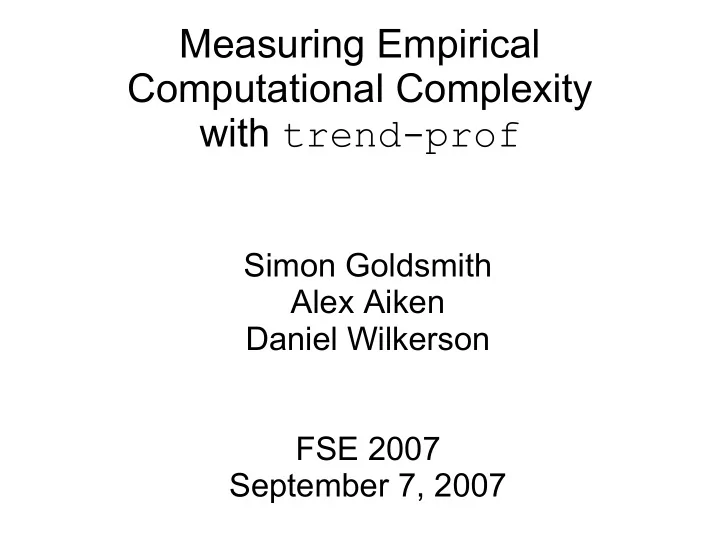

Measuring Empirical Computational Complexity with trend-prof Simon Goldsmith Alex Aiken Daniel Wilkerson FSE 2007 September 7, 2007
Understanding Performance ● Existing tools – theoretical asymptotic complexity ● e.g., big- O bounds, big- Θ bounds – empirical profiling ● e.g., gprof ● We propose an “empirical asymptotic” tool – trend-prof
How does my code scale? ● Consider insertion sort ● Theoretical Asymptotic Complexity – worst case Θ (n^2) – best case Θ (n) – expected case depends on input distribution ● Empirical Profiling – e.g., 2% of total time ● trend-prof – empirically scales as, e.g., n^1.2
trend-prof measures workloads ● Run workloads and measure performance Workloads: w 1 Block 1: 1 Block 2: 61 ... Block 5: 1770 ...
trend-prof ● Run workloads and measure performance Workloads: w 1 w 2 Block 1: 1 1 Block 2: 61 201 ... Block 5: 1770 19900 ...
trend-prof ● Run workloads and measure performance Workloads: w 1 w 2 ... w 60 Block 1: 1 1 ... 1 Block 2: 61 201 ... 60001 ... Block 5: 1770 19900 ... 1.79997e9 ...
trend-prof ● Look for performance trends in each block Workloads: w 1 w 2 ... w 60 Block 1: 1 1 ... 1 Block 2: 61 201 ... 60001 ... Block 5: 1770 19900 ... 1.79997e9 ...
trend-prof: Input Size ● Look for performance trends in each block – with respect to user-specified input size Workloads: w 1 w 2 ... w 60 Input Size: 60 200 ... 60000 Block 1: 1 1 ... 1 Block 2: 61 201 ... 60001 ... Block 5: 1770 19900 ... 1.79997e9 ...
Core Idea ● Relate performance of each basic block to input size Performance (Cost) Input Size
Uses of trend-prof ● Measure the performance trend an implementation exhibits on realistic workloads – and compare that to your expectations ● Identify locations that scale badly – may perform ok on smaller workloads, but dominate larger workloads
Example: bsort void bsort(int n, int *arr) { 1: int i=0; 2: while (i<n) { // O ( n 2 ) 3: int j=i+1; while (j<n) { // O ( n 2 ) 4: 5: if (arr[i] > arr[j]) 6: swap(&arr[i], &arr[j]); 7: j++; } 8: ++i; } }
Challenges ● How to relate performance to input size? ● How to summarize a large amount of data?
Problem: Too Many Basic Blocks Program Basic Blocks bzip 1032 maximus 1220 elsa 33647 banshee 13308 ● Leads to too many results to look at – Observation: Many basic blocks vary together
Summarize with Clusters ● Group basic blocks with similar performance into the same cluster
Empirical Fact: Clustering Works Basic Costly Program Blocks Clusters Clusters bzip 1032 23 10 maximus 1220 13 9 elsa 33647 1489 30 banshee 13308 859 26 ● Furthermore most clusters are small and cheap – a cluster is “costly” if it accounts for more than 2% of total performance on any workload
Clusters for bsort void bsort(int n, int *arr) { 1: int i=0; 2: while (i<n) { 3: int j=i+1; 4: while (j<n) { 5: if (arr[i] > arr[j]) 6: swap(&arr[i], &arr[j]); 7: j++; } 8: ++i; } }
Cluster Total as Matrix Row ● Relate total executions of each cluster to input size
Relate Performance to Input Size ● Powerlaw regression is great ● (Cost) = a (Input Size) b – Linear regression on (log Input Size, log Cost) ● Captures the high-order term – logarithmic factors don't matter in practice – polynomials converge to high order term
Powerlaw fit
Output: bsort max cost Cluster Total as a (billions of R 2 Cluster function of input basic block size executions) 11 Compares 3.1 n 2.00 1.00 3.0 n 1.93 0.996 2.5 Swaps 22 n 1.00 < 1 Size 1.00
bsort: Plots ● log(size) vs ● residuals plot log(swaps cluster) – they are small ● slope = 1.93 – they are not random
trend-prof workloads run workloads input size matrix cluster scatter plots powerlaw fits matrix of cluster totals residuals plots powerlaw fit user trend-prof
Results
Confirmed Linear Scaling Cost Input Size ● Ukkonen's Algorithm (maximus) – Theoretical Complexity: O(n) – Empirical Complexity: ~ n
Empirical Complexity: Andersen's Slope = 1.98 log(Cost) log(Input Size) ● Andersen's points-to analysis (banshee) – Theoretical Complexity: O(n 3 ) – Empirical Complexity: ~ n 1.98
Empirical Complexity: GLR Slope = 1.13 log(Cost) log(Input Size) ● GLR C++ parser (elkhound / elsa) – Theoretical Complexity: O(n 3 ) – Empirical Complexity: ~n 1.13
How well do you know your code? Slope = 1.30 log(Cost) log(Input Size) ● Output routines (maximus) – Theoretical Complexity: O(n)? – Empirical Complexity: ~ n 1.30
Algorithms in context Slope = 1.21 R 2 = 0.95 ● The linear-time list append in banshee's parser is a bug
Algorithms in Context R 2 = 0.65 ● The linear time list append in elsa's name lookup code is not a bug
Results Recap ● Confirmed linear scaling (maximus) ● Empirical scalability (Andersen's, GLR) ● Unexpected behavior (maximus) ● Algorithms in context (elsa, banshee) – found a performance bug in banshee's parser
Technical Contributions ● trend-prof – a tool to measure empirical computational complexity ● Discovery of the following empirical facts – programs have few costly clusters – powerlaw fits work well
Conclusion ● trend-prof models total basic block count of a cluster as a powerlaw function (y = ax b ) of user-specified input size – enables thorough comparison of your expectations about scalability to empirical reality – finds locations that scale badly
download trend-prof at http://trend-prof.tigris.org
Recommend
More recommend